Entrepreneurship and Small Business Management: Venture Impact
VerifiedAdded on 2024/05/29
|18
|4535
|406
Report
AI Summary
This report provides a comprehensive analysis of entrepreneurial ventures, focusing on different types such as lifestyle, smaller profit, and high-growth ventures, and examines their similarities and differences. It assesses the impact of micro and small businesses on the UK economy, supported by relevant data and statistics, highlighting their role in job creation, innovation, and poverty reduction. The report also explains the importance of small businesses and start-ups in the growth of the social economy, particularly in sectors like services, wholesale and retail trade, and hospitality. Additionally, it discusses the traits and skills of successful entrepreneurs, how their personality reflects entrepreneurial motivation, and how background and experience can influence entrepreneurship. The analysis uses Audley Travel, a UK-based tour company, as a case example to illustrate these concepts.

Entrepreneurship and Small Business Management
Paraphrase This Document
Need a fresh take? Get an instant paraphrase of this document with our AI Paraphraser
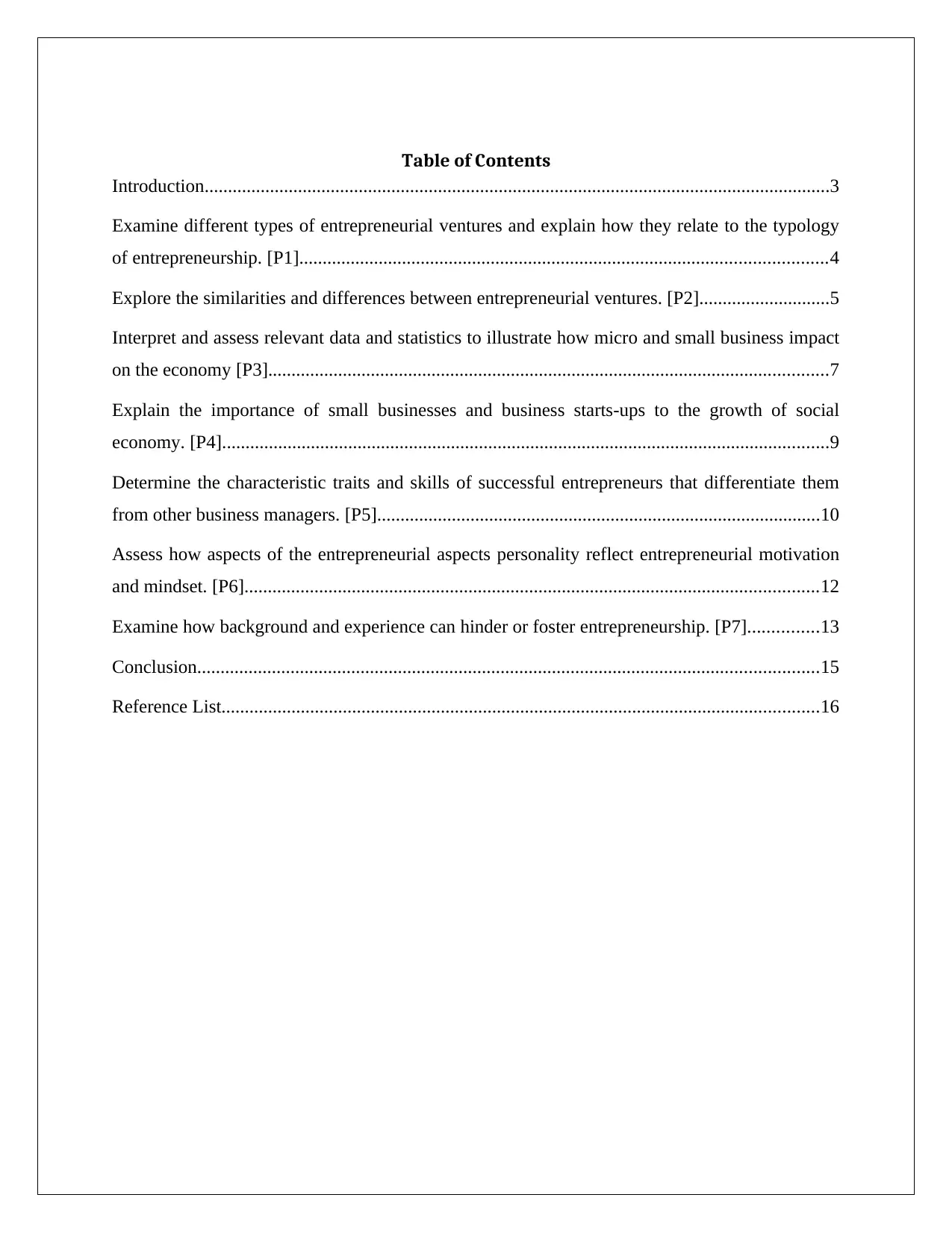
Table of Contents
Introduction......................................................................................................................................3
Examine different types of entrepreneurial ventures and explain how they relate to the typology
of entrepreneurship. [P1].................................................................................................................4
Explore the similarities and differences between entrepreneurial ventures. [P2]............................5
Interpret and assess relevant data and statistics to illustrate how micro and small business impact
on the economy [P3]........................................................................................................................7
Explain the importance of small businesses and business starts-ups to the growth of social
economy. [P4]..................................................................................................................................9
Determine the characteristic traits and skills of successful entrepreneurs that differentiate them
from other business managers. [P5]...............................................................................................10
Assess how aspects of the entrepreneurial aspects personality reflect entrepreneurial motivation
and mindset. [P6]...........................................................................................................................12
Examine how background and experience can hinder or foster entrepreneurship. [P7]...............13
Conclusion.....................................................................................................................................15
Reference List................................................................................................................................16
Introduction......................................................................................................................................3
Examine different types of entrepreneurial ventures and explain how they relate to the typology
of entrepreneurship. [P1].................................................................................................................4
Explore the similarities and differences between entrepreneurial ventures. [P2]............................5
Interpret and assess relevant data and statistics to illustrate how micro and small business impact
on the economy [P3]........................................................................................................................7
Explain the importance of small businesses and business starts-ups to the growth of social
economy. [P4]..................................................................................................................................9
Determine the characteristic traits and skills of successful entrepreneurs that differentiate them
from other business managers. [P5]...............................................................................................10
Assess how aspects of the entrepreneurial aspects personality reflect entrepreneurial motivation
and mindset. [P6]...........................................................................................................................12
Examine how background and experience can hinder or foster entrepreneurship. [P7]...............13
Conclusion.....................................................................................................................................15
Reference List................................................................................................................................16

Introduction
Risk taking behaviour with planning and strategic thinking, which results in the formation of
new venture by an organization or by individual, is termed as Entrepreneurship. They are
generally the founders of the business enterprise that can be either a local retail store or a self-
employed business. In this kind of business, the individual can change the way of working like
changes in the organizational structure or introducing a new product. When an individual invest
in a business as an entrepreneur then he/she is taking a very high risk which may be either
successful or will be disastrous also. Entrepreneur should have high energy level with self-
confidence and have the passion to succeed (Wiklund and Shepherd, 2016).
Generally, all entrepreneurs start their business with a small enterprise that could have one of
fever employees and has been independently operated by the owner. Small business enterprise
can be of many types like starting a new venture, taking the franchise or buying an existing
venture. Here in this report there will be a discussion of a UK based tour and travel company
Audley Travel a small business enterprise who wants to introduce a new branch or business in
the UK.
Risk taking behaviour with planning and strategic thinking, which results in the formation of
new venture by an organization or by individual, is termed as Entrepreneurship. They are
generally the founders of the business enterprise that can be either a local retail store or a self-
employed business. In this kind of business, the individual can change the way of working like
changes in the organizational structure or introducing a new product. When an individual invest
in a business as an entrepreneur then he/she is taking a very high risk which may be either
successful or will be disastrous also. Entrepreneur should have high energy level with self-
confidence and have the passion to succeed (Wiklund and Shepherd, 2016).
Generally, all entrepreneurs start their business with a small enterprise that could have one of
fever employees and has been independently operated by the owner. Small business enterprise
can be of many types like starting a new venture, taking the franchise or buying an existing
venture. Here in this report there will be a discussion of a UK based tour and travel company
Audley Travel a small business enterprise who wants to introduce a new branch or business in
the UK.
⊘ This is a preview!⊘
Do you want full access?
Subscribe today to unlock all pages.

Trusted by 1+ million students worldwide
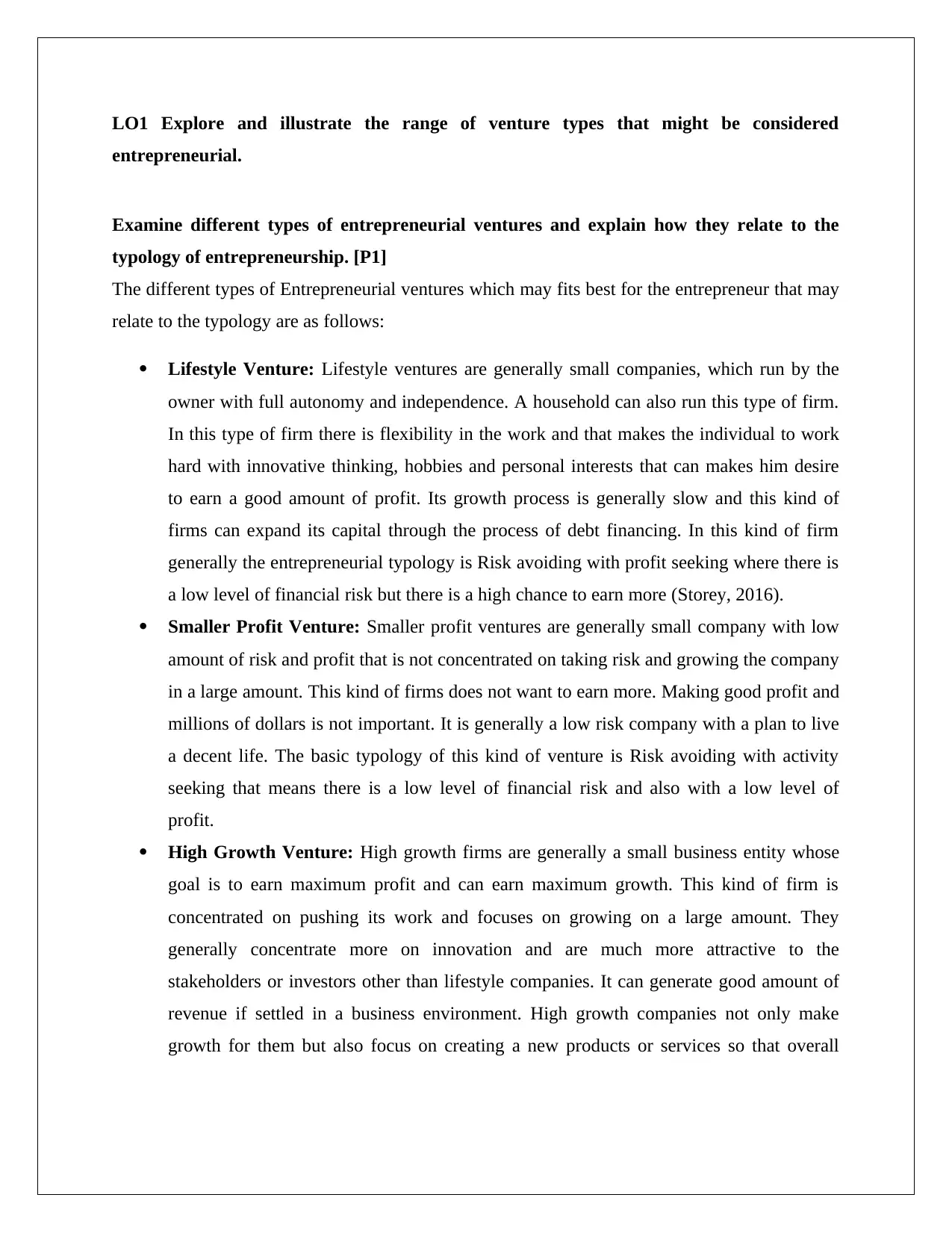
LO1 Explore and illustrate the range of venture types that might be considered
entrepreneurial.
Examine different types of entrepreneurial ventures and explain how they relate to the
typology of entrepreneurship. [P1]
The different types of Entrepreneurial ventures which may fits best for the entrepreneur that may
relate to the typology are as follows:
Lifestyle Venture: Lifestyle ventures are generally small companies, which run by the
owner with full autonomy and independence. A household can also run this type of firm.
In this type of firm there is flexibility in the work and that makes the individual to work
hard with innovative thinking, hobbies and personal interests that can makes him desire
to earn a good amount of profit. Its growth process is generally slow and this kind of
firms can expand its capital through the process of debt financing. In this kind of firm
generally the entrepreneurial typology is Risk avoiding with profit seeking where there is
a low level of financial risk but there is a high chance to earn more (Storey, 2016).
Smaller Profit Venture: Smaller profit ventures are generally small company with low
amount of risk and profit that is not concentrated on taking risk and growing the company
in a large amount. This kind of firms does not want to earn more. Making good profit and
millions of dollars is not important. It is generally a low risk company with a plan to live
a decent life. The basic typology of this kind of venture is Risk avoiding with activity
seeking that means there is a low level of financial risk and also with a low level of
profit.
High Growth Venture: High growth firms are generally a small business entity whose
goal is to earn maximum profit and can earn maximum growth. This kind of firm is
concentrated on pushing its work and focuses on growing on a large amount. They
generally concentrate more on innovation and are much more attractive to the
stakeholders or investors other than lifestyle companies. It can generate good amount of
revenue if settled in a business environment. High growth companies not only make
growth for them but also focus on creating a new products or services so that overall
entrepreneurial.
Examine different types of entrepreneurial ventures and explain how they relate to the
typology of entrepreneurship. [P1]
The different types of Entrepreneurial ventures which may fits best for the entrepreneur that may
relate to the typology are as follows:
Lifestyle Venture: Lifestyle ventures are generally small companies, which run by the
owner with full autonomy and independence. A household can also run this type of firm.
In this type of firm there is flexibility in the work and that makes the individual to work
hard with innovative thinking, hobbies and personal interests that can makes him desire
to earn a good amount of profit. Its growth process is generally slow and this kind of
firms can expand its capital through the process of debt financing. In this kind of firm
generally the entrepreneurial typology is Risk avoiding with profit seeking where there is
a low level of financial risk but there is a high chance to earn more (Storey, 2016).
Smaller Profit Venture: Smaller profit ventures are generally small company with low
amount of risk and profit that is not concentrated on taking risk and growing the company
in a large amount. This kind of firms does not want to earn more. Making good profit and
millions of dollars is not important. It is generally a low risk company with a plan to live
a decent life. The basic typology of this kind of venture is Risk avoiding with activity
seeking that means there is a low level of financial risk and also with a low level of
profit.
High Growth Venture: High growth firms are generally a small business entity whose
goal is to earn maximum profit and can earn maximum growth. This kind of firm is
concentrated on pushing its work and focuses on growing on a large amount. They
generally concentrate more on innovation and are much more attractive to the
stakeholders or investors other than lifestyle companies. It can generate good amount of
revenue if settled in a business environment. High growth companies not only make
growth for them but also focus on creating a new products or services so that overall
Paraphrase This Document
Need a fresh take? Get an instant paraphrase of this document with our AI Paraphraser

industry can grow. Their topology is Risk accepting with profit seeking which means
there is a high level of financial risk in with a motive to earn high profit (Burns, 2016).
Fig: 1 Typology of Entrepreneurial Styles
(Source: Burns, 2016)
Explore the similarities and differences between entrepreneurial ventures. [P2]
Similarities between Entrepreneurial Ventures:
There are various similarities between the entrepreneurial ventures, which are discussed below:
One of the basic similarities between these entrepreneurial ventures is to earn profit.
Every venture has the motive to earn profit, which can be either high or low. If some
companies is taking high risk then they will earn high profit and if some company is not
taking any risk or low risk then the company will earn low amount of profit. but every
venture has the goal to earn profit.
As the name suggests, a small business enterprise, suggests that there is no intention for
the company to grow big. They can grow their business in a medium scale but a company
with fever employees who generally chooses to keep its business small. This is common
in all business ventures which is Entrepreneurial based. There are few ventures that run
by a entrepreneur is one man operation work who single handily all the work in the
venture (Goss, 2015).
there is a high level of financial risk in with a motive to earn high profit (Burns, 2016).
Fig: 1 Typology of Entrepreneurial Styles
(Source: Burns, 2016)
Explore the similarities and differences between entrepreneurial ventures. [P2]
Similarities between Entrepreneurial Ventures:
There are various similarities between the entrepreneurial ventures, which are discussed below:
One of the basic similarities between these entrepreneurial ventures is to earn profit.
Every venture has the motive to earn profit, which can be either high or low. If some
companies is taking high risk then they will earn high profit and if some company is not
taking any risk or low risk then the company will earn low amount of profit. but every
venture has the goal to earn profit.
As the name suggests, a small business enterprise, suggests that there is no intention for
the company to grow big. They can grow their business in a medium scale but a company
with fever employees who generally chooses to keep its business small. This is common
in all business ventures which is Entrepreneurial based. There are few ventures that run
by a entrepreneur is one man operation work who single handily all the work in the
venture (Goss, 2015).
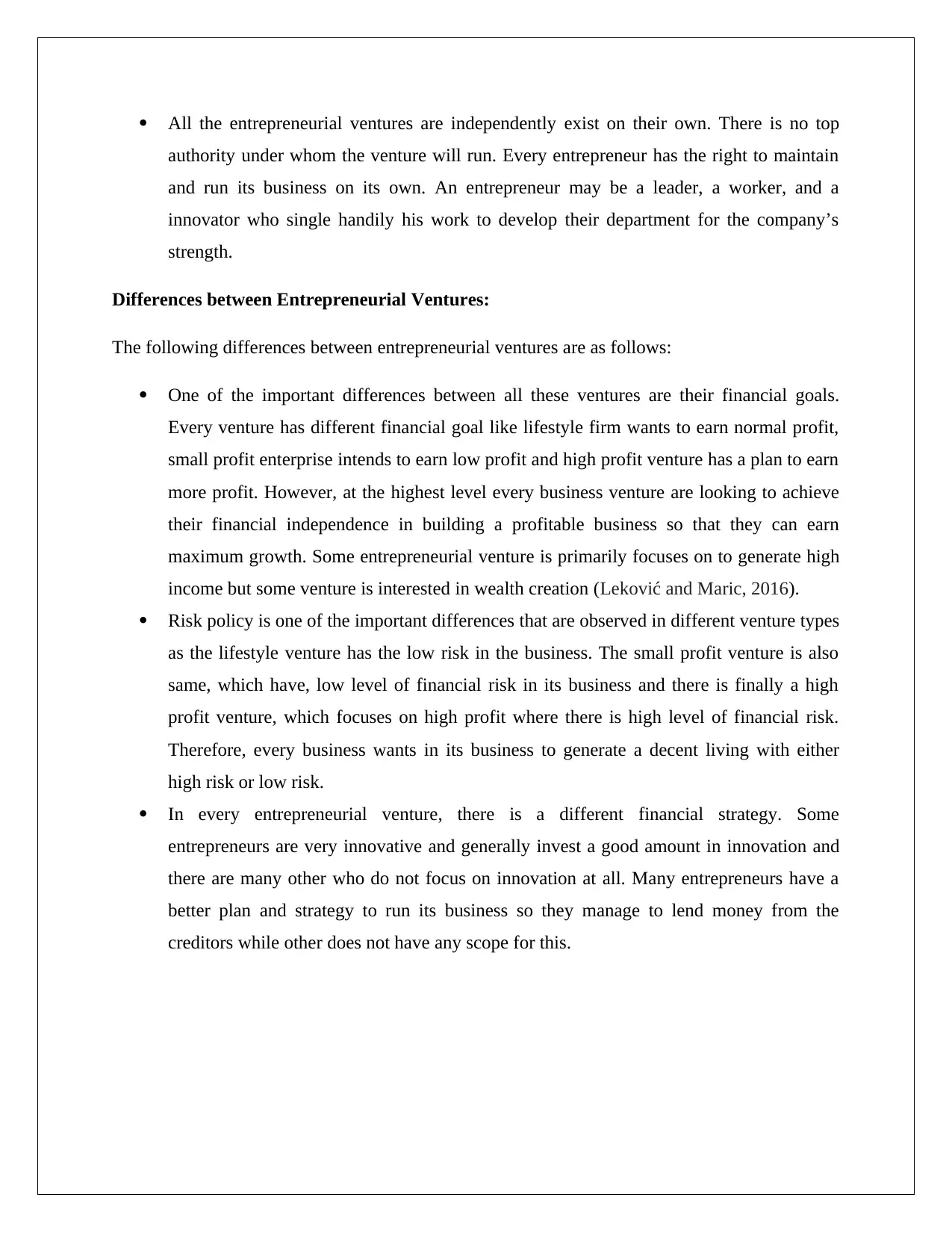
All the entrepreneurial ventures are independently exist on their own. There is no top
authority under whom the venture will run. Every entrepreneur has the right to maintain
and run its business on its own. An entrepreneur may be a leader, a worker, and a
innovator who single handily his work to develop their department for the company’s
strength.
Differences between Entrepreneurial Ventures:
The following differences between entrepreneurial ventures are as follows:
One of the important differences between all these ventures are their financial goals.
Every venture has different financial goal like lifestyle firm wants to earn normal profit,
small profit enterprise intends to earn low profit and high profit venture has a plan to earn
more profit. However, at the highest level every business venture are looking to achieve
their financial independence in building a profitable business so that they can earn
maximum growth. Some entrepreneurial venture is primarily focuses on to generate high
income but some venture is interested in wealth creation (Leković and Maric, 2016).
Risk policy is one of the important differences that are observed in different venture types
as the lifestyle venture has the low risk in the business. The small profit venture is also
same, which have, low level of financial risk in its business and there is finally a high
profit venture, which focuses on high profit where there is high level of financial risk.
Therefore, every business wants in its business to generate a decent living with either
high risk or low risk.
In every entrepreneurial venture, there is a different financial strategy. Some
entrepreneurs are very innovative and generally invest a good amount in innovation and
there are many other who do not focus on innovation at all. Many entrepreneurs have a
better plan and strategy to run its business so they manage to lend money from the
creditors while other does not have any scope for this.
authority under whom the venture will run. Every entrepreneur has the right to maintain
and run its business on its own. An entrepreneur may be a leader, a worker, and a
innovator who single handily his work to develop their department for the company’s
strength.
Differences between Entrepreneurial Ventures:
The following differences between entrepreneurial ventures are as follows:
One of the important differences between all these ventures are their financial goals.
Every venture has different financial goal like lifestyle firm wants to earn normal profit,
small profit enterprise intends to earn low profit and high profit venture has a plan to earn
more profit. However, at the highest level every business venture are looking to achieve
their financial independence in building a profitable business so that they can earn
maximum growth. Some entrepreneurial venture is primarily focuses on to generate high
income but some venture is interested in wealth creation (Leković and Maric, 2016).
Risk policy is one of the important differences that are observed in different venture types
as the lifestyle venture has the low risk in the business. The small profit venture is also
same, which have, low level of financial risk in its business and there is finally a high
profit venture, which focuses on high profit where there is high level of financial risk.
Therefore, every business wants in its business to generate a decent living with either
high risk or low risk.
In every entrepreneurial venture, there is a different financial strategy. Some
entrepreneurs are very innovative and generally invest a good amount in innovation and
there are many other who do not focus on innovation at all. Many entrepreneurs have a
better plan and strategy to run its business so they manage to lend money from the
creditors while other does not have any scope for this.
⊘ This is a preview!⊘
Do you want full access?
Subscribe today to unlock all pages.

Trusted by 1+ million students worldwide
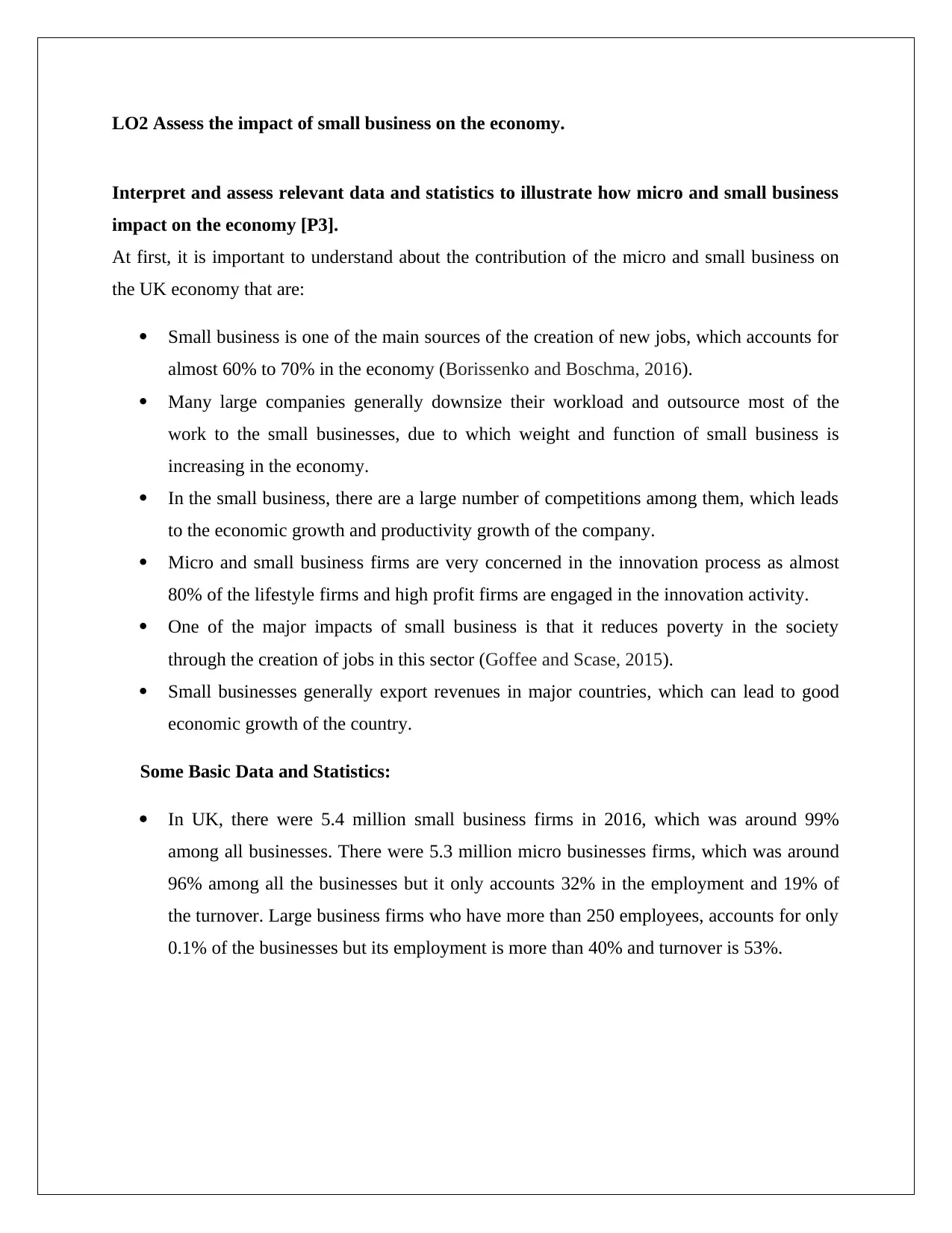
LO2 Assess the impact of small business on the economy.
Interpret and assess relevant data and statistics to illustrate how micro and small business
impact on the economy [P3].
At first, it is important to understand about the contribution of the micro and small business on
the UK economy that are:
Small business is one of the main sources of the creation of new jobs, which accounts for
almost 60% to 70% in the economy (Borissenko and Boschma, 2016).
Many large companies generally downsize their workload and outsource most of the
work to the small businesses, due to which weight and function of small business is
increasing in the economy.
In the small business, there are a large number of competitions among them, which leads
to the economic growth and productivity growth of the company.
Micro and small business firms are very concerned in the innovation process as almost
80% of the lifestyle firms and high profit firms are engaged in the innovation activity.
One of the major impacts of small business is that it reduces poverty in the society
through the creation of jobs in this sector (Goffee and Scase, 2015).
Small businesses generally export revenues in major countries, which can lead to good
economic growth of the country.
Some Basic Data and Statistics:
In UK, there were 5.4 million small business firms in 2016, which was around 99%
among all businesses. There were 5.3 million micro businesses firms, which was around
96% among all the businesses but it only accounts 32% in the employment and 19% of
the turnover. Large business firms who have more than 250 employees, accounts for only
0.1% of the businesses but its employment is more than 40% and turnover is 53%.
Interpret and assess relevant data and statistics to illustrate how micro and small business
impact on the economy [P3].
At first, it is important to understand about the contribution of the micro and small business on
the UK economy that are:
Small business is one of the main sources of the creation of new jobs, which accounts for
almost 60% to 70% in the economy (Borissenko and Boschma, 2016).
Many large companies generally downsize their workload and outsource most of the
work to the small businesses, due to which weight and function of small business is
increasing in the economy.
In the small business, there are a large number of competitions among them, which leads
to the economic growth and productivity growth of the company.
Micro and small business firms are very concerned in the innovation process as almost
80% of the lifestyle firms and high profit firms are engaged in the innovation activity.
One of the major impacts of small business is that it reduces poverty in the society
through the creation of jobs in this sector (Goffee and Scase, 2015).
Small businesses generally export revenues in major countries, which can lead to good
economic growth of the country.
Some Basic Data and Statistics:
In UK, there were 5.4 million small business firms in 2016, which was around 99%
among all businesses. There were 5.3 million micro businesses firms, which was around
96% among all the businesses but it only accounts 32% in the employment and 19% of
the turnover. Large business firms who have more than 250 employees, accounts for only
0.1% of the businesses but its employment is more than 40% and turnover is 53%.
Paraphrase This Document
Need a fresh take? Get an instant paraphrase of this document with our AI Paraphraser
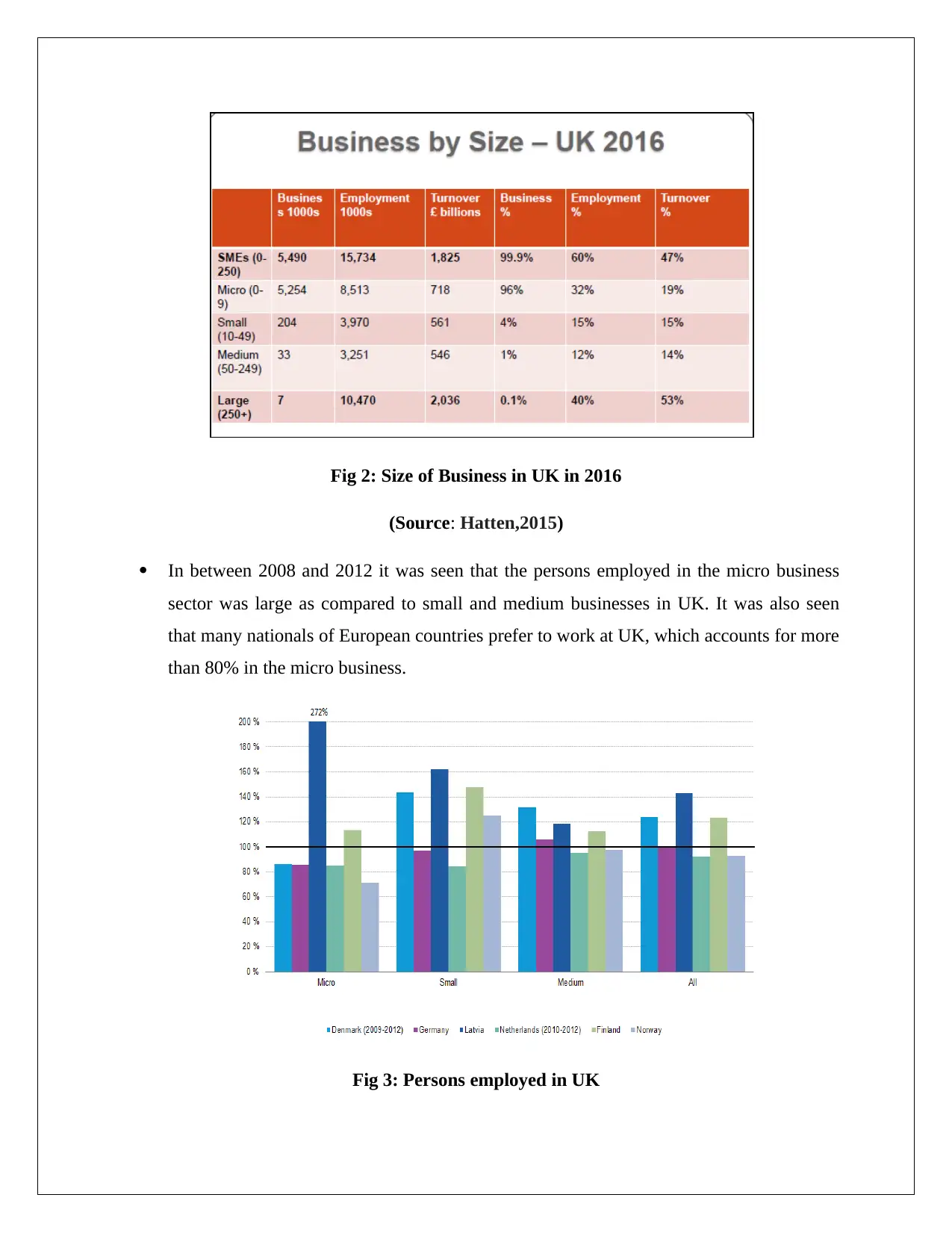
Fig 2: Size of Business in UK in 2016
(Source: Hatten,2015)
In between 2008 and 2012 it was seen that the persons employed in the micro business
sector was large as compared to small and medium businesses in UK. It was also seen
that many nationals of European countries prefer to work at UK, which accounts for more
than 80% in the micro business.
Fig 3: Persons employed in UK
(Source: Hatten,2015)
In between 2008 and 2012 it was seen that the persons employed in the micro business
sector was large as compared to small and medium businesses in UK. It was also seen
that many nationals of European countries prefer to work at UK, which accounts for more
than 80% in the micro business.
Fig 3: Persons employed in UK
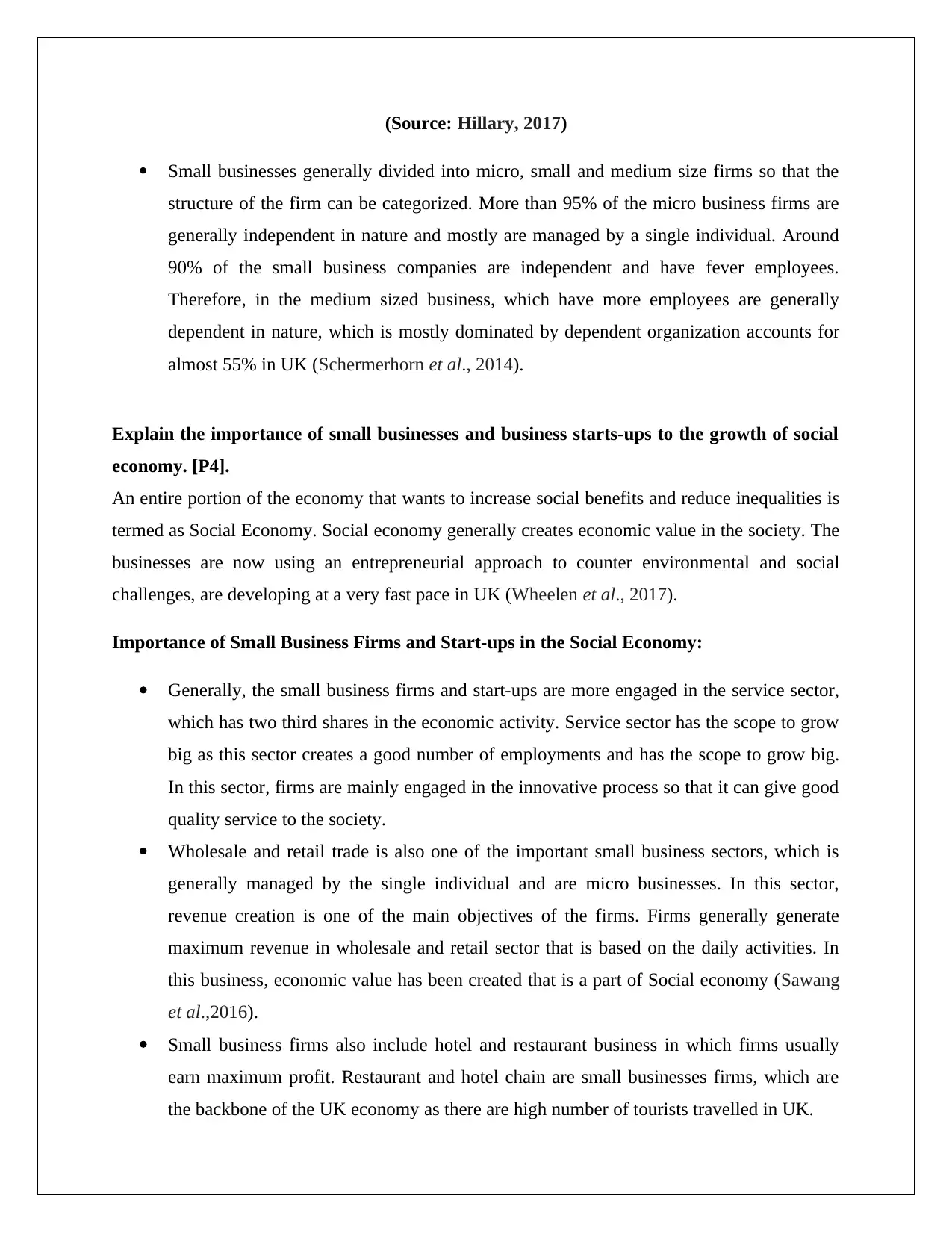
(Source: Hillary, 2017)
Small businesses generally divided into micro, small and medium size firms so that the
structure of the firm can be categorized. More than 95% of the micro business firms are
generally independent in nature and mostly are managed by a single individual. Around
90% of the small business companies are independent and have fever employees.
Therefore, in the medium sized business, which have more employees are generally
dependent in nature, which is mostly dominated by dependent organization accounts for
almost 55% in UK (Schermerhorn et al., 2014).
Explain the importance of small businesses and business starts-ups to the growth of social
economy. [P4].
An entire portion of the economy that wants to increase social benefits and reduce inequalities is
termed as Social Economy. Social economy generally creates economic value in the society. The
businesses are now using an entrepreneurial approach to counter environmental and social
challenges, are developing at a very fast pace in UK (Wheelen et al., 2017).
Importance of Small Business Firms and Start-ups in the Social Economy:
Generally, the small business firms and start-ups are more engaged in the service sector,
which has two third shares in the economic activity. Service sector has the scope to grow
big as this sector creates a good number of employments and has the scope to grow big.
In this sector, firms are mainly engaged in the innovative process so that it can give good
quality service to the society.
Wholesale and retail trade is also one of the important small business sectors, which is
generally managed by the single individual and are micro businesses. In this sector,
revenue creation is one of the main objectives of the firms. Firms generally generate
maximum revenue in wholesale and retail sector that is based on the daily activities. In
this business, economic value has been created that is a part of Social economy (Sawang
et al.,2016).
Small business firms also include hotel and restaurant business in which firms usually
earn maximum profit. Restaurant and hotel chain are small businesses firms, which are
the backbone of the UK economy as there are high number of tourists travelled in UK.
Small businesses generally divided into micro, small and medium size firms so that the
structure of the firm can be categorized. More than 95% of the micro business firms are
generally independent in nature and mostly are managed by a single individual. Around
90% of the small business companies are independent and have fever employees.
Therefore, in the medium sized business, which have more employees are generally
dependent in nature, which is mostly dominated by dependent organization accounts for
almost 55% in UK (Schermerhorn et al., 2014).
Explain the importance of small businesses and business starts-ups to the growth of social
economy. [P4].
An entire portion of the economy that wants to increase social benefits and reduce inequalities is
termed as Social Economy. Social economy generally creates economic value in the society. The
businesses are now using an entrepreneurial approach to counter environmental and social
challenges, are developing at a very fast pace in UK (Wheelen et al., 2017).
Importance of Small Business Firms and Start-ups in the Social Economy:
Generally, the small business firms and start-ups are more engaged in the service sector,
which has two third shares in the economic activity. Service sector has the scope to grow
big as this sector creates a good number of employments and has the scope to grow big.
In this sector, firms are mainly engaged in the innovative process so that it can give good
quality service to the society.
Wholesale and retail trade is also one of the important small business sectors, which is
generally managed by the single individual and are micro businesses. In this sector,
revenue creation is one of the main objectives of the firms. Firms generally generate
maximum revenue in wholesale and retail sector that is based on the daily activities. In
this business, economic value has been created that is a part of Social economy (Sawang
et al.,2016).
Small business firms also include hotel and restaurant business in which firms usually
earn maximum profit. Restaurant and hotel chain are small businesses firms, which are
the backbone of the UK economy as there are high number of tourists travelled in UK.
⊘ This is a preview!⊘
Do you want full access?
Subscribe today to unlock all pages.

Trusted by 1+ million students worldwide
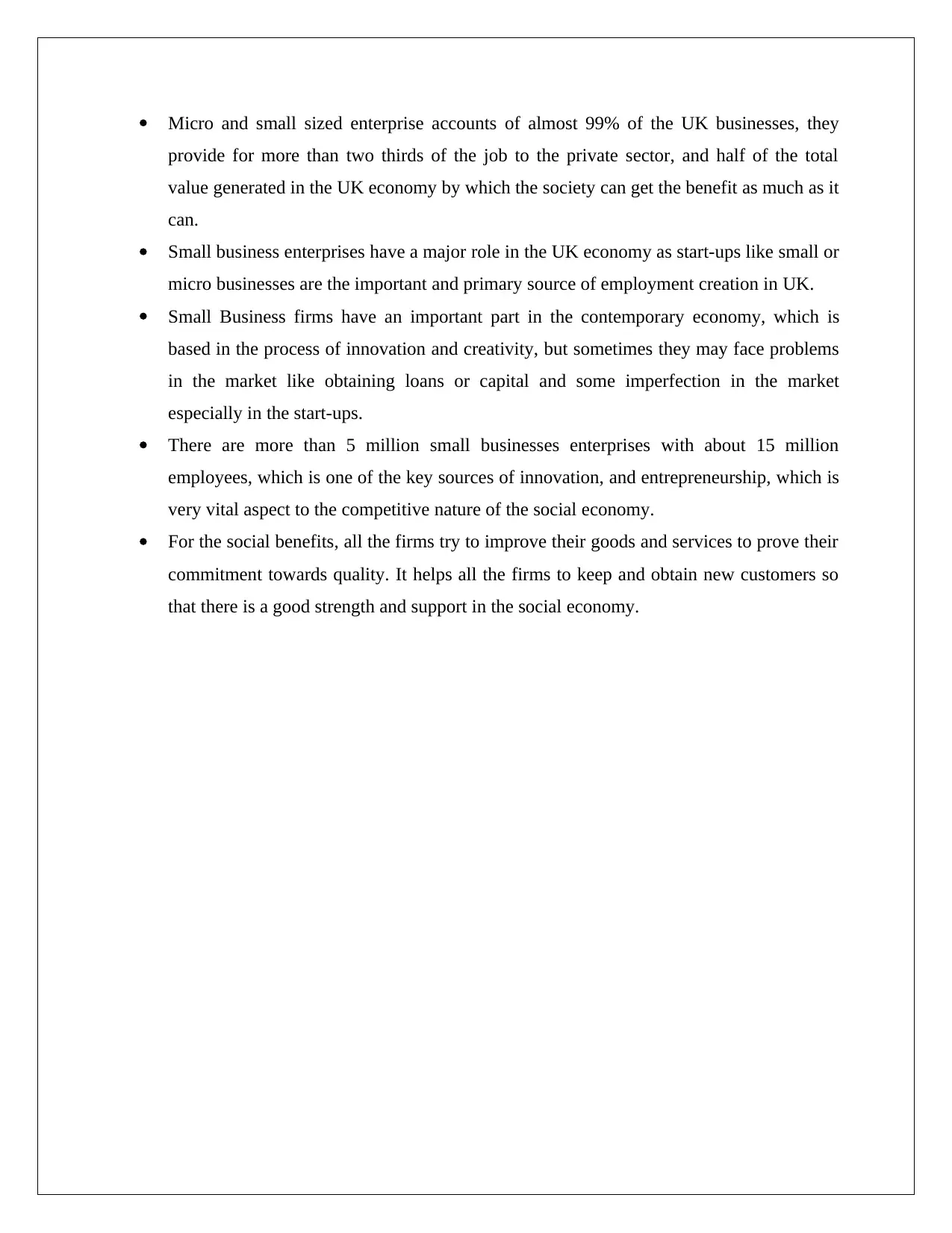
Micro and small sized enterprise accounts of almost 99% of the UK businesses, they
provide for more than two thirds of the job to the private sector, and half of the total
value generated in the UK economy by which the society can get the benefit as much as it
can.
Small business enterprises have a major role in the UK economy as start-ups like small or
micro businesses are the important and primary source of employment creation in UK.
Small Business firms have an important part in the contemporary economy, which is
based in the process of innovation and creativity, but sometimes they may face problems
in the market like obtaining loans or capital and some imperfection in the market
especially in the start-ups.
There are more than 5 million small businesses enterprises with about 15 million
employees, which is one of the key sources of innovation, and entrepreneurship, which is
very vital aspect to the competitive nature of the social economy.
For the social benefits, all the firms try to improve their goods and services to prove their
commitment towards quality. It helps all the firms to keep and obtain new customers so
that there is a good strength and support in the social economy.
provide for more than two thirds of the job to the private sector, and half of the total
value generated in the UK economy by which the society can get the benefit as much as it
can.
Small business enterprises have a major role in the UK economy as start-ups like small or
micro businesses are the important and primary source of employment creation in UK.
Small Business firms have an important part in the contemporary economy, which is
based in the process of innovation and creativity, but sometimes they may face problems
in the market like obtaining loans or capital and some imperfection in the market
especially in the start-ups.
There are more than 5 million small businesses enterprises with about 15 million
employees, which is one of the key sources of innovation, and entrepreneurship, which is
very vital aspect to the competitive nature of the social economy.
For the social benefits, all the firms try to improve their goods and services to prove their
commitment towards quality. It helps all the firms to keep and obtain new customers so
that there is a good strength and support in the social economy.
Paraphrase This Document
Need a fresh take? Get an instant paraphrase of this document with our AI Paraphraser
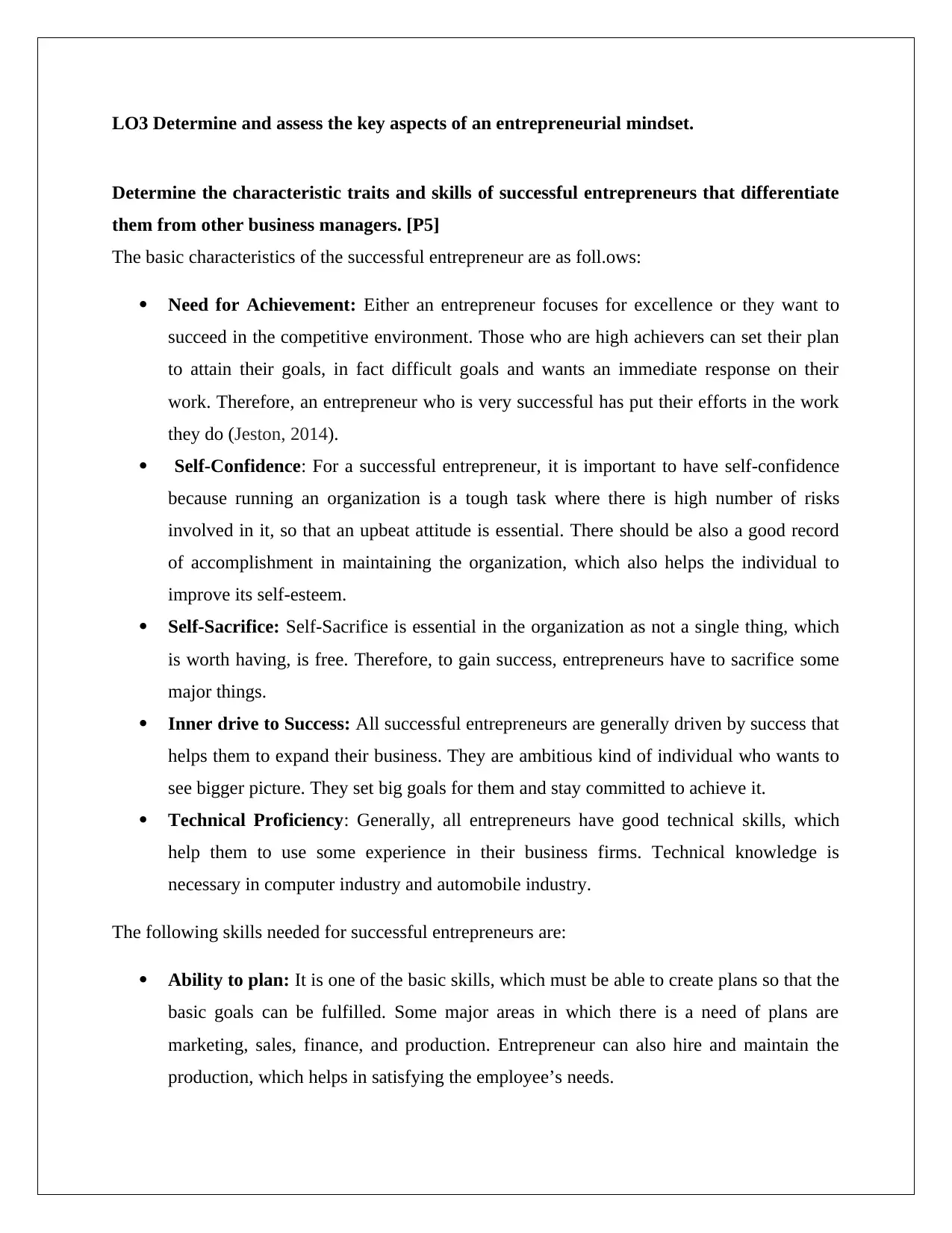
LO3 Determine and assess the key aspects of an entrepreneurial mindset.
Determine the characteristic traits and skills of successful entrepreneurs that differentiate
them from other business managers. [P5]
The basic characteristics of the successful entrepreneur are as foll.ows:
Need for Achievement: Either an entrepreneur focuses for excellence or they want to
succeed in the competitive environment. Those who are high achievers can set their plan
to attain their goals, in fact difficult goals and wants an immediate response on their
work. Therefore, an entrepreneur who is very successful has put their efforts in the work
they do (Jeston, 2014).
Self-Confidence: For a successful entrepreneur, it is important to have self-confidence
because running an organization is a tough task where there is high number of risks
involved in it, so that an upbeat attitude is essential. There should be also a good record
of accomplishment in maintaining the organization, which also helps the individual to
improve its self-esteem.
Self-Sacrifice: Self-Sacrifice is essential in the organization as not a single thing, which
is worth having, is free. Therefore, to gain success, entrepreneurs have to sacrifice some
major things.
Inner drive to Success: All successful entrepreneurs are generally driven by success that
helps them to expand their business. They are ambitious kind of individual who wants to
see bigger picture. They set big goals for them and stay committed to achieve it.
Technical Proficiency: Generally, all entrepreneurs have good technical skills, which
help them to use some experience in their business firms. Technical knowledge is
necessary in computer industry and automobile industry.
The following skills needed for successful entrepreneurs are:
Ability to plan: It is one of the basic skills, which must be able to create plans so that the
basic goals can be fulfilled. Some major areas in which there is a need of plans are
marketing, sales, finance, and production. Entrepreneur can also hire and maintain the
production, which helps in satisfying the employee’s needs.
Determine the characteristic traits and skills of successful entrepreneurs that differentiate
them from other business managers. [P5]
The basic characteristics of the successful entrepreneur are as foll.ows:
Need for Achievement: Either an entrepreneur focuses for excellence or they want to
succeed in the competitive environment. Those who are high achievers can set their plan
to attain their goals, in fact difficult goals and wants an immediate response on their
work. Therefore, an entrepreneur who is very successful has put their efforts in the work
they do (Jeston, 2014).
Self-Confidence: For a successful entrepreneur, it is important to have self-confidence
because running an organization is a tough task where there is high number of risks
involved in it, so that an upbeat attitude is essential. There should be also a good record
of accomplishment in maintaining the organization, which also helps the individual to
improve its self-esteem.
Self-Sacrifice: Self-Sacrifice is essential in the organization as not a single thing, which
is worth having, is free. Therefore, to gain success, entrepreneurs have to sacrifice some
major things.
Inner drive to Success: All successful entrepreneurs are generally driven by success that
helps them to expand their business. They are ambitious kind of individual who wants to
see bigger picture. They set big goals for them and stay committed to achieve it.
Technical Proficiency: Generally, all entrepreneurs have good technical skills, which
help them to use some experience in their business firms. Technical knowledge is
necessary in computer industry and automobile industry.
The following skills needed for successful entrepreneurs are:
Ability to plan: It is one of the basic skills, which must be able to create plans so that the
basic goals can be fulfilled. Some major areas in which there is a need of plans are
marketing, sales, finance, and production. Entrepreneur can also hire and maintain the
production, which helps in satisfying the employee’s needs.
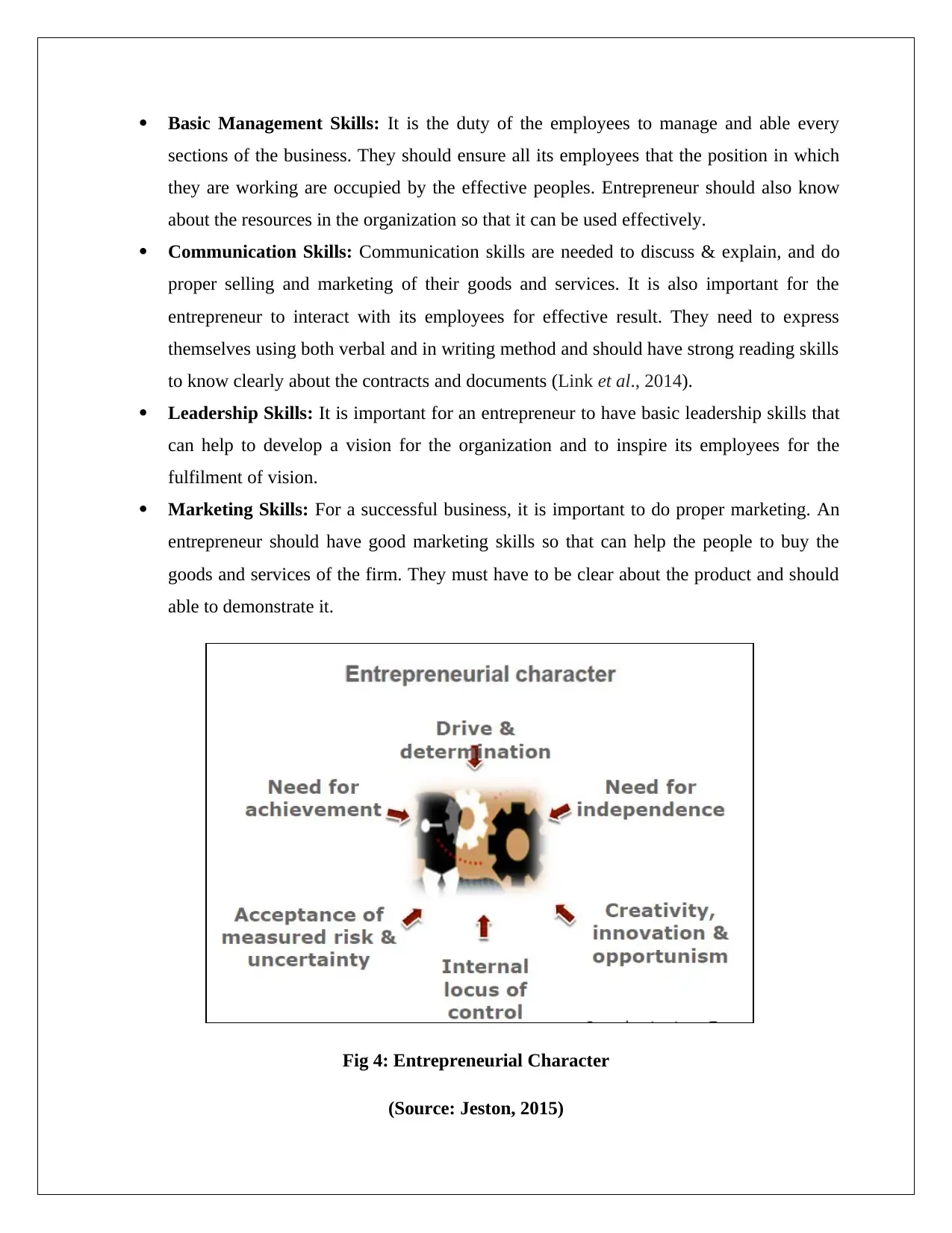
Basic Management Skills: It is the duty of the employees to manage and able every
sections of the business. They should ensure all its employees that the position in which
they are working are occupied by the effective peoples. Entrepreneur should also know
about the resources in the organization so that it can be used effectively.
Communication Skills: Communication skills are needed to discuss & explain, and do
proper selling and marketing of their goods and services. It is also important for the
entrepreneur to interact with its employees for effective result. They need to express
themselves using both verbal and in writing method and should have strong reading skills
to know clearly about the contracts and documents (Link et al., 2014).
Leadership Skills: It is important for an entrepreneur to have basic leadership skills that
can help to develop a vision for the organization and to inspire its employees for the
fulfilment of vision.
Marketing Skills: For a successful business, it is important to do proper marketing. An
entrepreneur should have good marketing skills so that can help the people to buy the
goods and services of the firm. They must have to be clear about the product and should
able to demonstrate it.
Fig 4: Entrepreneurial Character
(Source: Jeston, 2015)
sections of the business. They should ensure all its employees that the position in which
they are working are occupied by the effective peoples. Entrepreneur should also know
about the resources in the organization so that it can be used effectively.
Communication Skills: Communication skills are needed to discuss & explain, and do
proper selling and marketing of their goods and services. It is also important for the
entrepreneur to interact with its employees for effective result. They need to express
themselves using both verbal and in writing method and should have strong reading skills
to know clearly about the contracts and documents (Link et al., 2014).
Leadership Skills: It is important for an entrepreneur to have basic leadership skills that
can help to develop a vision for the organization and to inspire its employees for the
fulfilment of vision.
Marketing Skills: For a successful business, it is important to do proper marketing. An
entrepreneur should have good marketing skills so that can help the people to buy the
goods and services of the firm. They must have to be clear about the product and should
able to demonstrate it.
Fig 4: Entrepreneurial Character
(Source: Jeston, 2015)
⊘ This is a preview!⊘
Do you want full access?
Subscribe today to unlock all pages.

Trusted by 1+ million students worldwide
1 out of 18
Related Documents
Your All-in-One AI-Powered Toolkit for Academic Success.
+13062052269
info@desklib.com
Available 24*7 on WhatsApp / Email
![[object Object]](/_next/static/media/star-bottom.7253800d.svg)
Unlock your academic potential
Copyright © 2020–2025 A2Z Services. All Rights Reserved. Developed and managed by ZUCOL.




